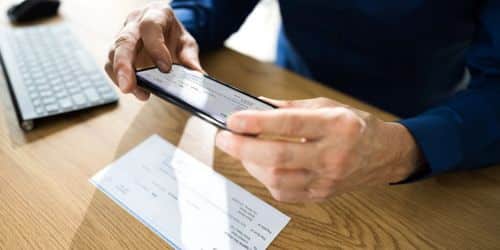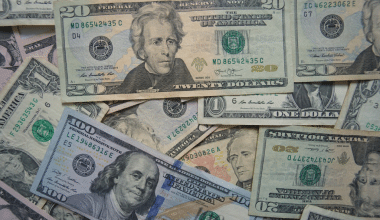Checks are practical for a variety of transactions. They may be necessary on occasion from the person or business you are paying, and on other occasions, they may save you from irksome debit card or credit card transaction fees. If you’ve never sent a check via email but would like to, you might be unsure if it’s possible. It is undoubtedly possible to send a check via email. Although it isn’t as simple as writing a paper check, sending a check by email ensures that the recipient receives it right away. However, not everyone will accept a check sent to them via email. A regular check that is electronically sent and received via email is known as a “check” or “digital check.” Many entrepreneurs prefer email checks because of their quicker processing times and increased security. There are numerous approaches to take.
All the information you require about sending and receiving a check via email is provided in the following paragraphs.
Can You Email a Check
eChecks and digital checks are the two main types of checks that can be sent via email.
eChecks
You can get eChecks by clicking on a link that is typically provided by the merchant or other person you are paying. On that link, you can enter information such as your bank account and routing number as well as other details. An automated clearing house, or ACH, a transaction known as an eCheck allows for quick payments to be made securely and directly from a checking or savings account. E-checks have more security features than traditional checks, including authentication, digital signatures, public-key cryptography, and encryption.
E-checks also referred to as electronic checks, are becoming more and more popular among businesses because they perform similarly to traditional paper checks. The check will be cashed digitally. To transfer money from your checking account to the payee, you must first write a paper check. You must then sign the check after writing the payee’s name and the amount you wish to transfer.
An e-check allows you to electronically send a payment to the recipient after you have authorized a withdrawal from your account. You will electronically approve the transaction rather than physically signing a paper check by agreeing to the terms and conditions of a website, speaking your agreement, or signing a contract. For the time being, both small and large businesses accept and disperse payments using the e-check system. Use for oneself is less typical. Businesses may issue employee paychecks, settle vendor bills, and accept payments in the form of electronic checks from clients. Businesses may send you electronic checks.
Sending an eCheck Through Email
The easiest way to pay for a service is with an eCheck, but the company or person accepting the payment must accept them as a form of payment. Adding that data to their eCheck portal is possible if they do. They will request information about your bank account, the check amount in full, occasionally an invoice number (which they will give you), as well as some private details like your name and contact information.
Digital Checks
eChecks are distinct from digital checks. They are digital checks that contain every piece of information found on a typical paper check. You can print them out or deposit them electronically. Unlike an eCheck, a digital check resembles a paper check more. A digital check may be delivered via email in a few different ways:
#1. Different Apps and Email Checking Software
Digital checks, including eChecks, can be made using a variety of apps and software. You can manage email payments with the aid of software programs like Checkbook, Deluxe eChecks, and Paynote. If you run a business, you can also set up the option to accept payments by email check.
#2. Taking a Picture of Your Check
The front and back of a paper check can be photographed after being filled out as a quick and easy way to send a digital check. The person or company you are paying for might not be able to use this, as some banks and depository institutions might not accept in-person check deposits with a check image. However, a remote deposit capture using a smartphone and a picture might be more widely accepted.
You can upload a check remotely using online banking or deposit it at your neighborhood bank. Digital checks use technology that has some security risks, even though they have many advantages. Users should be aware of these risks.
Benefits of Accepting Checks By Email
You can get quick, dependable, secure, and simple-to-reissue payments by accepting emailed checks in addition to other advantages. Paper checks are less eco-friendly than checks sent via email.
#1. Cost-Effectiveness
E-check processing is less expensive for businesses than, say, credit card processing. Indeed, according to Intuit, companies can cut their costs associated with processing payments by as much as 60%, which will benefit their bottom line. It is less expensive to use an eCheck or another type of digital check than paper checks. When using paper checks, you will be required to pay for the physical check, whereas some emailed checks are free. These expenses may also increase due to travel and mailing expenses for paper checks.
#2. Ease of Use
This is especially true for companies that handle a lot of paper checks. By switching to electronic checks, Intuit claims that the likelihood of human error is decreased and that account reconciliation is made simple by software.
#3. Reliability and Security
Money transfers using the ACH network have proven to be dependable. A further security feature of e-checks is data encryption. You might start using email checks for regular transactions in the not-too-distant future. Although e-checks are common among businesses, the consumer market hasn’t yet fully embraced the trend.
#4. Fast and Reliable
You can receive your money almost immediately if you use an email check. This helps businesses with accounting and cash flow. Additionally, you can pay bills immediately instead of having to wait for paper checks to be cleared by the bank of another business before paying expenses like rent, inventory, or salaries.
#5. Easily Reissued
The process for issuing a new digital check is much simpler than issuing a new paper check, even though you could accidentally delete the email containing it. You need only get in touch with the payer to ask for a new digital item.
#6. Secure
To protect your sensitive information, emailed checks go through authentication and encryption procedures. As a result, even if your check were stolen, a thief would not be able to decrypt the information it contains.
Electronic checks are time-stamped with a digital signature, leaving a trace of the location and time the payer sent the initial check.
#7. More Convenient To Send Money Than Physical Checks
Physical inspections can occasionally be bothersome for several reasons. To fill out the forms, you must have our checkbook or individual checks; if not, you must order copies. If you require them immediately, you might also need to visit your neighborhood bank branch. Delivery of the check to the individual or company you are paying for is another drawback. This could entail going to the destination (person, company, or post office). Most of these issues rarely arise with checks that are sent via email!
Cons of Accepting Checks By Email
However convenient payment processing has become a result of technological advancement, and there are now more security issues to be aware of. Sending and receiving checks via email is generally secure, but there are some potential risks.
#1. Security Breach or Cyberattack
A cyberattack or data leak is always a possibility with modern technology. Your financial information or banking information could be accessed by an outside party and used against you if your computer or smartphone is stolen or compromised.
But robust encryption and sophisticated security measures greatly reduce the likelihood that a third party could access your banking information.
#2. Bank Accounts May Be Vulnerable If Your Email Is Hacked
Some software will give you access to a secure portal where you can store your data. However, if your email account is hacked and you email a picture of a check, hackers may be able to access your private financial data. Therefore, although emailed checks provide some additional security over paper checks, they also carry a variety of special risks.
#3. Some Bank Branches Might Not Accept Checks Sent via Email
Depending on their bank, the person you are sending a digital check to might not be able to process it. So, before authorizing an email check, ask the recipient to double-check the information with their bank, credit union, or other depository institution.
#4. Fake Check
Email checks are subject to fraud, just like paper checks. Watch out for these indications of a fake check:
- Exceptionally good image. Image processing software is used to produce fake checks, giving them a clear, professional appearance.
- The check number in the upper right corner does not correspond to the first or third number on the magnetic ink character recognition (MICR) line.
- The top left has no bank logo or name.
- The routing and account numbers are not included in the MICR line.
Emailed Checks: Printing and Depositing
You might be unsure if your bank recognizes electronic checks when you receive one via email. The answer is yes. Checks sent via email are typically accepted by banks. Checks sent via email can be printed and deposited in your bank or using an online banking tool, just like checks sent via regular mail.
Steps for Printing Checks From Email
To print out emails with checks, you must have access to a printer. Regular printer paper will work just fine, but if you intend to receive recurring payments online, you might want to buy specialty check stock paper.
If you want to deposit the check at a bank or ATM nearby, you must use magnetic ink. The magnetic ink on bank devices and ATMs can be read to determine the payer’s account number. The check cannot be processed by the bank if this ink is missing.
Your check’s acceptance by the bank is influenced by the check’s image quality. Any smudged or blurred lines may prevent the institution from accepting the check. A check must have the following information to be accepted by a bank:
- Routing number
- Account number
- Payee’s name
- Written payment amount
- Date with signature
Make sure your check prints with all the words and numbers legible to avoid having to go back and reprint it.
How to Deposit Checks From Email
If you want to deposit a check after it has been printed, you can do so at the bank or online with a banking app. The check can be used in your bank just like a regular paper check by being deposited with a teller or an ATM.
Additionally, the majority of significant banks provide a mobile app that enables quick depositing of scanned checks by taking a photo of them. Using this app, you can deposit checks, both paper and digital. By providing your banking details in a secure online form, you can use some services to instantly deposit emailed checks.
Best Practices for Accepting Emailed Checks
A security risk will always exist when sending or receiving a check via email, but overall, the advantages outweigh the disadvantages. When accepting an email check, bear the following advice in mind.
Print a second copy of your check for your records in case you need to refer to it in the future. If you manage your finances with a spreadsheet or a banking app, you should keep track of the check amount and deposit date. You can gauge the length of the process by looking at these actions.
If you use mobile deposit, check your banking frequently to make sure the money from your check has been deposited into your account. If the funds do not appear in a day or two, get in touch with your neighborhood bank.
Is It Safe to Email a Picture of a Check?
Yes, to a point. Even though email isn’t always secure, sending a copy of a check via email should be secure enough if you take precautions. Writing a check technically exposes your account information to anyone who can obtain a copy.
The issue with sending checks via email is that they pass through numerous computers, some of which might be infected with malicious software. Checks include your name, address, and account number along with other details about your finances. Through the use of this information, identity thieves may gain access to your account and take money that you have worked hard to earn.
Can You Mobile Deposit a Photocopy of a Check?
Checks that have been received for payment can be scanned and used as collateral for a digital deposit. The image is treated legally the same as the original object. Yes, you can! Mobile deposits make use of a check image, provided that your copy is clear. Once your check is scanned, uploaded, and photographed along with your deposit request, the information is encrypted and sent to your bank. Once the check has been processed and cleared, the money can be deposited into your account.
How Do I Cash a Digital Check?
Checks may be deposited into your bank account using a mobile banking feature called mobile check deposit.
- Using your bank’s mobile app, you can remotely deposit checks or take a picture of an eCheck.
- ATM deposits that make use of OCR technology.
- A teller is present inside the branch.
How Do I Print an Email Check?
Checks sent by email can be printed and deposited in your bank or with an online banking application, just like checks sent by regular mail. A printer, check printing software, blank checks, magnetic ink, and a MICR font are all required.
- Get software for printing checks
- Acquire check stock paper
- Obtain and set up a MICR font.
- Fill in the account and routing information, your contact information, etc.
- Go over the details with care.
- Print your checks
How Does Emailing a Check Work?
While an e-check functions largely similarly to a traditional check, you submit payment information (such as your bank account, routing number, and payment authorization) via an e-check authorization form as opposed to ripping a piece of paper out of your checkbook. By doing this, you get ready for an electronic payment processing.
Can I Just Send a Picture of a Check?
Sure, you can. Any paper reproduction of an original check, whether it be a photocopy, a photo printout, or a replacement check, is considered to be a copy of the original check. In essence, you can send a picture of the check instead of the actual check. The majority of banks accept electronic checks. You can print electronic checks and deposit them at your bank or online, just like paper checks.
Conclusion
The mail is a viable option for sending checks. Electronic checks, or eChecks, are the two main types of checks sent via email. Virtual checks that you fill out online or images of paper checks are both examples of digital checks. eChecks, on the other hand, are ACH payment options that go directly to the account of the recipient and need your bank details. As long as you are aware of who you are sending the money to and how much it is, transferring and cashing an email check is easy and quick.
Related Articles
- HOW LONG DO CHECKS LAST?
- Can I Write a Check to Myself? Simple Steps to Do This Effortlessly!!!
- Service Email: Meaning, Examples and Top Providers
- HOW DO YOU WRITE A CHECK?: Step by Step Comprehensive Guide






